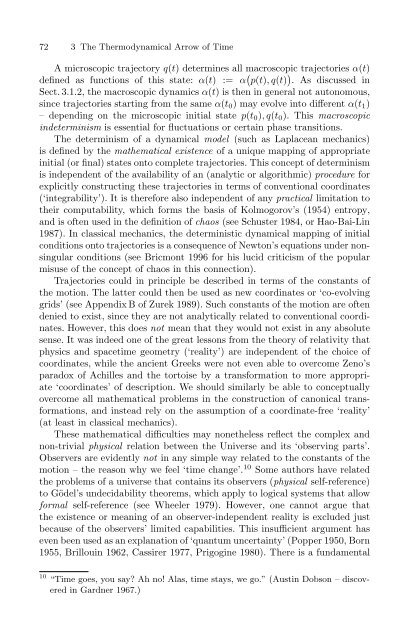The Physical Basis of The Direction of Time (The Frontiers ...
The Physical Basis of The Direction of Time (The Frontiers ...
The Physical Basis of The Direction of Time (The Frontiers ...
Create successful ePaper yourself
Turn your PDF publications into a flip-book with our unique Google optimized e-Paper software.
72 3 <strong>The</strong> <strong>The</strong>rmodynamical Arrow <strong>of</strong> <strong>Time</strong><br />
A microscopic trajectory q(t) determines all macroscopic trajectories α(t)<br />
defined as functions <strong>of</strong> this state: α(t) := α ( p(t),q(t) ) . As discussed in<br />
Sect. 3.1.2, the macroscopic dynamics α(t) is then in general not autonomous,<br />
since trajectories starting from the same α(t 0 ) may evolve into different α(t 1 )<br />
– depending on the microscopic initial state p(t 0 ),q(t 0 ). This macroscopic<br />
indeterminism is essential for fluctuations or certain phase transitions.<br />
<strong>The</strong> determinism <strong>of</strong> a dynamical model (such as Laplacean mechanics)<br />
is defined by the mathematical existence <strong>of</strong> a unique mapping <strong>of</strong> appropriate<br />
initial (or final) states onto complete trajectories. This concept <strong>of</strong> determinism<br />
is independent <strong>of</strong> the availability <strong>of</strong> an (analytic or algorithmic) procedure for<br />
explicitly constructing these trajectories in terms <strong>of</strong> conventional coordinates<br />
(‘integrability’). It is therefore also independent <strong>of</strong> any practical limitation to<br />
their computability, which forms the basis <strong>of</strong> Kolmogorov’s (1954) entropy,<br />
and is <strong>of</strong>ten used in the definition <strong>of</strong> chaos (see Schuster 1984, or Hao-Bai-Lin<br />
1987). In classical mechanics, the deterministic dynamical mapping <strong>of</strong> initial<br />
conditions onto trajectories is a consequence <strong>of</strong> Newton’s equations under nonsingular<br />
conditions (see Bricmont 1996 for his lucid criticism <strong>of</strong> the popular<br />
misuse <strong>of</strong> the concept <strong>of</strong> chaos in this connection).<br />
Trajectories could in principle be described in terms <strong>of</strong> the constants <strong>of</strong><br />
the motion. <strong>The</strong> latter could then be used as new coordinates or ‘co-evolving<br />
grids’ (see Appendix B <strong>of</strong> Zurek 1989). Such constants <strong>of</strong> the motion are <strong>of</strong>ten<br />
denied to exist, since they are not analytically related to conventional coordinates.<br />
However, this does not mean that they would not exist in any absolute<br />
sense. It was indeed one <strong>of</strong> the great lessons from the theory <strong>of</strong> relativity that<br />
physics and spacetime geometry (‘reality’) are independent <strong>of</strong> the choice <strong>of</strong><br />
coordinates, while the ancient Greeks were not even able to overcome Zeno’s<br />
paradox <strong>of</strong> Achilles and the tortoise by a transformation to more appropriate<br />
‘coordinates’ <strong>of</strong> description. We should similarly be able to conceptually<br />
overcome all mathematical problems in the construction <strong>of</strong> canonical transformations,<br />
and instead rely on the assumption <strong>of</strong> a coordinate-free ‘reality’<br />
(at least in classical mechanics).<br />
<strong>The</strong>se mathematical difficulties may nonetheless reflect the complex and<br />
non-trivial physical relation between the Universe and its ‘observing parts’.<br />
Observers are evidently not in any simple way related to the constants <strong>of</strong> the<br />
motion – the reason why we feel ‘time change’. 10 Some authors have related<br />
the problems <strong>of</strong> a universe that contains its observers (physical self-reference)<br />
to Gödel’s undecidability theorems, which apply to logical systems that allow<br />
formal self-reference (see Wheeler 1979). However, one cannot argue that<br />
the existence or meaning <strong>of</strong> an observer-independent reality is excluded just<br />
because <strong>of</strong> the observers’ limited capabilities. This insufficient argument has<br />
even been used as an explanation <strong>of</strong> ‘quantum uncertainty’ (Popper 1950, Born<br />
1955, Brillouin 1962, Cassirer 1977, Prigogine 1980). <strong>The</strong>re is a fundamental<br />
10 “<strong>Time</strong> goes, you say? Ah no! Alas, time stays, we go.” (Austin Dobson – discovered<br />
in Gardner 1967.)



![arXiv:1001.0993v1 [hep-ph] 6 Jan 2010](https://img.yumpu.com/51282177/1/190x245/arxiv10010993v1-hep-ph-6-jan-2010.jpg?quality=85)


![arXiv:1008.3907v2 [astro-ph.CO] 1 Nov 2011](https://img.yumpu.com/48909562/1/190x245/arxiv10083907v2-astro-phco-1-nov-2011.jpg?quality=85)








![arXiv:1002.4928v1 [gr-qc] 26 Feb 2010](https://img.yumpu.com/41209516/1/190x245/arxiv10024928v1-gr-qc-26-feb-2010.jpg?quality=85)
![arXiv:1206.2653v1 [astro-ph.CO] 12 Jun 2012](https://img.yumpu.com/39510078/1/190x245/arxiv12062653v1-astro-phco-12-jun-2012.jpg?quality=85)
